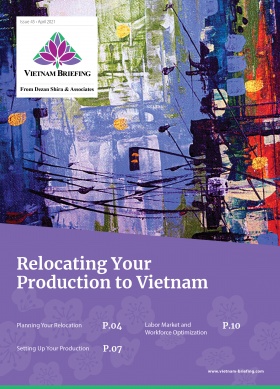What EU’s Sustained Investment Tells Us About Vietnam’s Business Environment
- Trade relations with the EU and Vietnam remain strong reaching around US$41.3 billion.
- Vietnam is the EU’s 16th largest trade partner brought in part by the recent EU-Vietnam free trade agreement.
- Vietnam Briefing highlights the increasing EU investment in Vietnam and the reasons why Vietnam has emerged as a strong contender for investment in Southeast Asia.
With a foreign trade volume of about US$41.3 billion, the EU is currently among Vietnam’s largest trading partners: according to the European Commission, Vietnam is the EU’s 16th-largest trade partner and within the Association of Southeast Asian Nations (ASEAN), the EU’s second-largest trading partner. Combined, ASEAN is the EU’s third-largest trading partner outside Europe (after the US and China).
As per the Ministry of Industry and Trade (MoIT), Vietnam’s exports to the EU increased by 28 percent year on year to reach nearly US$10 billion in Q1 2021. Overall shipments from some EU countries such as Denmark, Belgium, Portugal, and Italy grew by 20-25 percent.
The EU’s main exports to Vietnam are high tech products, including electrical machinery and equipment, aircraft, vehicles, and pharmaceutical products, while Vietnam’s main exports to the EU are telephone sets, electronic products, footwear, textiles and clothing, coffee, rice, seafood, and furniture.
EVFTA: implications and advantages
With the EU-Vietnam free trade agreement (EVFTA) in effect, the agreement implies increased competitiveness between EU and Vietnamese marketplaces. Foreign products, which may now enjoy a tariff advantage because of the abolition of import duties, should present significant competition for domestic products.
VinFast – a unit of Vietnam’s largest conglomerate Vingroup – is the country’s first fully-fledged domestic car manufacturer. Within the next five years, VinFast aims to produce about 250,000 cars annually, which is 92 percent of all cars sold in Vietnam last year. Exemption from customs barriers should benefit this plan, and also create new competition in the EU car market.
Those EU companies that regularly trade with Vietnam can find out whether and when their products can benefit from the customs exemption by checking the relevant customs tariff numbers (HS Codes) in the related documents of the European Trade Commission. The EU Commission distinguishes between A-products (immediate duty exemption) and B-products (from B3 to B15; duty exemption within three to 15 years).
In a report, research and advisory platform Germany Trade & Invest (GTAI) points out that the EVFTA provides better access to public procurements in Vietnam. EU companies can take part in public projects and PPP projects more easily with the agreement in force, leaving their footprint in Vietnam.
Thanks to the current ratified investment agreement EU-Vietnam Investment Protection Agreement (EVIPA), in which the EU and Vietnam have both decided to facilitate the investment environment for companies from both sides (including strengthening the legal framework, especially intellectual property), it should be easier for EU companies to invest in the previously highly restricted sector. For example, the maximum foreign shareholding in commercial banks has been increased from 30 percent to 49 percent.
In addition, EU companies can benefit from the non-economic provisions of the EVFTA; the agreement is also intended to enforce much-criticized environmental and human rights standards in Vietnam and, for instance, to ban forced labor. The free trade agreement aims to promote democratic values in Vietnam and thus make the country more attractive for EU investors.
In light of this, we look at three key EU members that are investing significantly and have an increasingly strong trade relationship with Vietnam.
The UK
The UK and Vietnam on December 29, 2020, signed the UK Vietnam free trade agreement (UKVFTA) as the UK transitions out of the EU. The agreement paves the way for continued and increasing trade between both countries. The agreement will see the elimination of virtually all customs duties between the two countries. The British embassy in Vietnam has forecast that Vietnam will save US$151 million in tariffs from the deal while the UK stands to save around US$36 million.
Vietnam is the second-largest Southeast Asian exporter to the UK after Thailand with bilateral trade between the two countries equaling US$6.7 billion in 2019. Main exports to the UK included mobile phones, garments and textiles, and seafood. The UK is also looking to Vietnam for goods and services such as education, renewable energy, technology, infrastructure, and healthcare. In fact, it is the largest foreign investor in Vietnam’s education sector.
Italy
Since 2013, when a strategic partnership was established between both the countries, bilateral trade between Italy and Vietnam and investments have witnessed significant growth.
In the first four months of 2020, Vietnam’s export turnover to Italy reached US$914.4 million while imports reached US$505 million as per Vietnam’s General Statistics Office (GSO).
Italy has highly specialized industries such as textiles, foodstuffs, machines, eyewear, and so on while being the third economic power in the European continent. In addition, Italy ranks ninth among EU countries that have invested in Vietnam.
The majority of investment in Vietnam is wholly owned by Italian companies. Most Italian firms in Vietnam are in the pharmaceuticals, transportation, machines, and foodstuff industries.
The Italian economic system has strong opportunities for growth in many industries, particularly the ones with a high level of specialization such as eyewear (20 percent, eliminated in three years), home decor (10-25 percent, eliminated in three years), machines (leather machines, stone working machines, vending machines, electrical lighting, and signaling equipment, etc.) and remanufactured goods (aerospace, heavy-duty and off-road equipment, motor vehicle parts, IT, medical devices, tires, etc.), as well as specialized services such as architectural and engineering services.
Germany
Currently, Germany is Vietnam’s largest EU trading partner, with bilateral trade in goods having quadrupled in the last 10 years. There are more than 350 German companies present in the Vietnam market as of the end of 2020, of which 60 enterprises have established their manufacturing facilities in the country.
According to Vietnam Customs, by the end of November 2020, the total trade turnover between the two countries reached US$9.08 billion, of which, Vietnam’s export turnover reached US$6.05 billion, up 0.5 percent over the same period in 2019. This is an encouraging number in the context of a sharp decline in import demand globally caused by the pandemic.
Further, by the end of November 2020, Germany had 378 FDI projects with a total registered capital of more than US$2.2 billion, ranking 17th among 139 countries and territories investing in Vietnam.
Invested projects have focused on manufacturing, processing, technical services, information and communication, banking, and insurance. Some German multinational corporations have already invested in Vietnam such as Daimler-Chrysler, B. Braun, Messer, Siemens, Schaeffler, and Bosch. In addition, the automobile industry is especially attractive playing to Germany’s strengths. Major German automobile manufacturers have benefitted from significant opportunities due to preferential terms in the EVFTA.
EU investors remain confident in Vietnam’s business environment
Most recently, EuroCham’s Business Climate Index (BCI) Q1 2021 in a survey revealed that European business leaders remain confident in Vietnam’s economy, anticipating that Q2 performance will further improve. It goes on to say that apart from international travel restrictions, it’s business as usual in Vietnam. The BCI Index hit 73.9 points in Q1 2021 – the highest since Q3 2019. Business leaders also see benefits of the EVFTA with more than 60 percent benefitting from the agreement. However, the survey also noted that ‘administrative procedures’ was the biggest challenge to take advantage of the EVFTA.
According to ScandAsia magazine, high economic growth and strong investment infrastructure are some of the reasons why Northern European businesses consider Vietnam. It further said that Swedish exports to Vietnam increased by almost six percent in 2020 despite the pandemic. The report also said that while there are challenges, there remain opportunities for small and medium-sized enterprises in Vietnam.
Key takeaways
The developments in Vietnam described above emphasize the country’s potential and its increasing importance within Southeast Asia, which are not diminished because of the growing pressure of its “big brother” China (including the ongoing trade dispute with the US, rising wage costs, political unrest in Hong Kong and the outbreak of COVID-19).
The EVFTA, with its liberalization of customs duties and the deepening of trade and business relations, represents a great opportunity for EU companies. It will provide greater access to an emerging market with almost 100 million people, including about 55 million workers. In addition, the agreement opens opportunities for partnership, dialogue, and cooperation and creates stronger relations with the Southeast Asian region.
About Us
Vietnam Briefing is produced by Dezan Shira & Associates. The firm assists foreign investors throughout Asia from offices across the world, including in Hanoi, Ho Chi Minh City, and Da Nang. Readers may write to vietnam@dezshira.com for more support on doing business in Vietnam.
We also maintain offices or have alliance partners assisting foreign investors in Indonesia, India, Singapore, The Philippines, Malaysia, Thailand, Italy, Germany, and the United States, in addition to practices in Bangladesh and Russia.
- Previous Article Vietnam’s Improving Business Environment Amid Pandemic: Provincial Competitive Index 2020
- Next Article Vietnam’s Wine Industry and Opportunities for Australian Investors






























